We had been looking forward to the tour that friend, Alex, had planned for us, with much excitement. After what, at times, has been a very hot summer in the U.K., the day dawned rather dull, but still pleasantly warm as we set off for our London adventure.
London Bridge Station
It was our first visit to the “big smoke” for over a year. We had agreed to meet at London Bridge Station, which was an event in itself, as the station has undergone a huge transformation in recent years and is very different to how I remembered it.
Having come down an escalator from the platforms to a vast concourse, Alex was waiting to greet us. A minor problem almost occurred as while walking to an exit, I threw our tickets into a litter bin. We then came across exit gates. I had presumed having had our tickets inspected on the train, and having left the platforms, we no longer needed the tickets. Not so. Every exit has gates and I needed the tickets to be allowed through. I had to go back and rummage through the litter bins. Not finding the tickets, I was beginning to panic. Then I realised it was the wrong bin and had to burrow into another, where they were, fortunately, retrieved.
Although I worked in London for many years, it was in the West End, a different area of the city. Our tour was to the eastern side, with which I was not so familiar. In the 20 plus years since I worked there, the skyline has changed out of all recognition. Most of the area we visited was new to Dennis.
The Shard
On leaving London Bridge Station our first sighting was of the Shard. You could hardly miss it being London’s tallest building at 309.6 metres, or 1,016 feet, and a very unusual shape. Building was completed in 2012. There are 72 floors of mixed business sectors, including the London Shangri-La Hotel and a public viewing area.
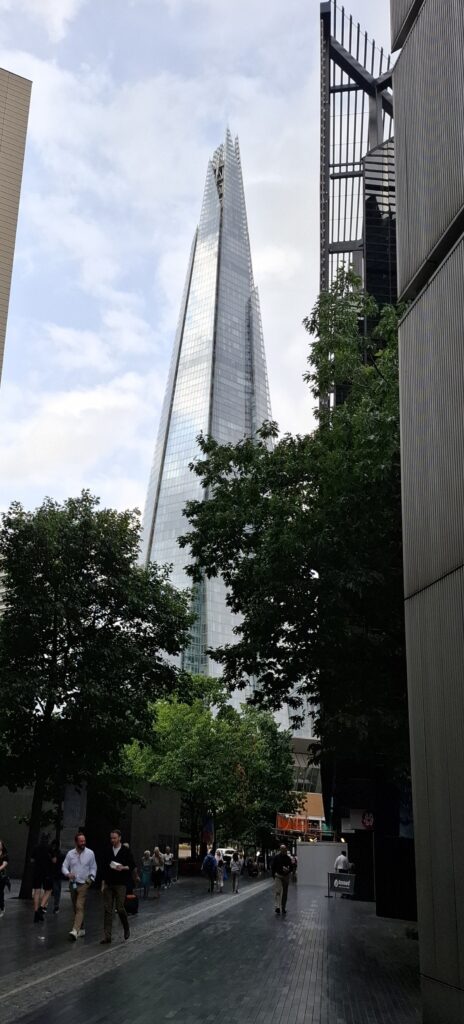
The area around London Bridge has been completely reformed. What were warehouses and dockyard buildings have now become smart, modern architectural masterpieces. Many in this area are offices of prestigious accounting firms.
Amazing view
Walking along the riverside walk beside the Thames, along with many tourists, we admired the view on the opposite bank. Contrasting brand new tower blocks of fascinating shapes and sizes, intermingled with historical buildings, such as the Tower of London, Saint Paul’s Cathedral and the spires of various churches.
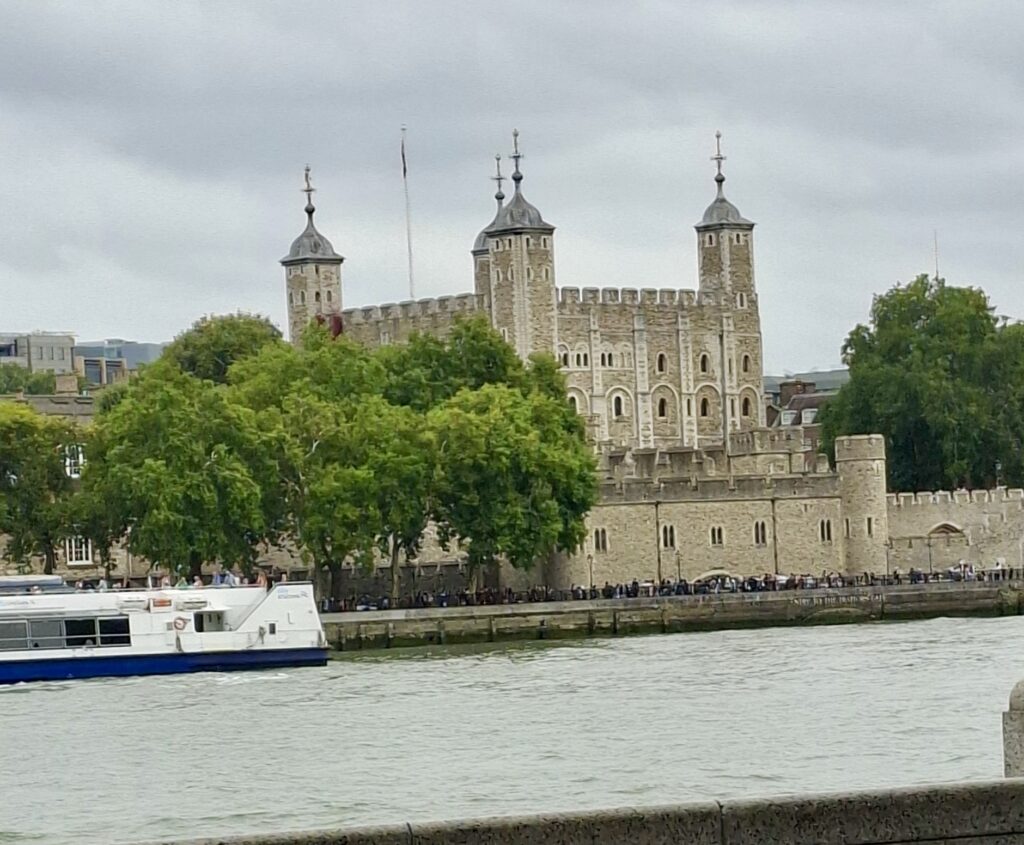
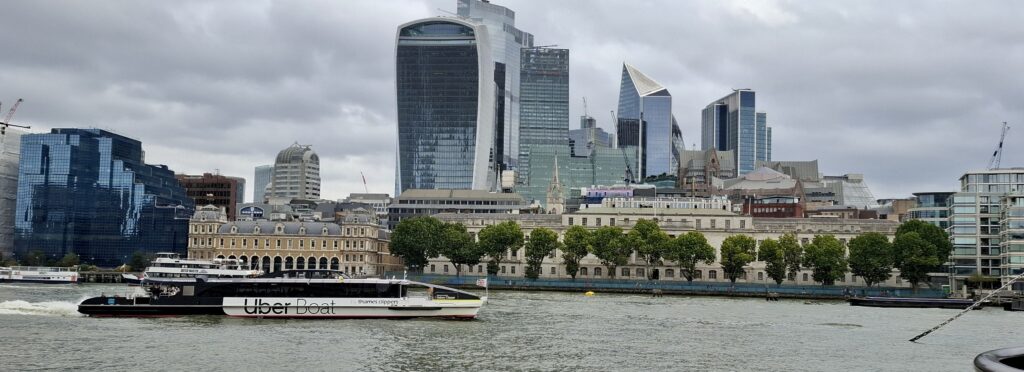
HMS Belfast
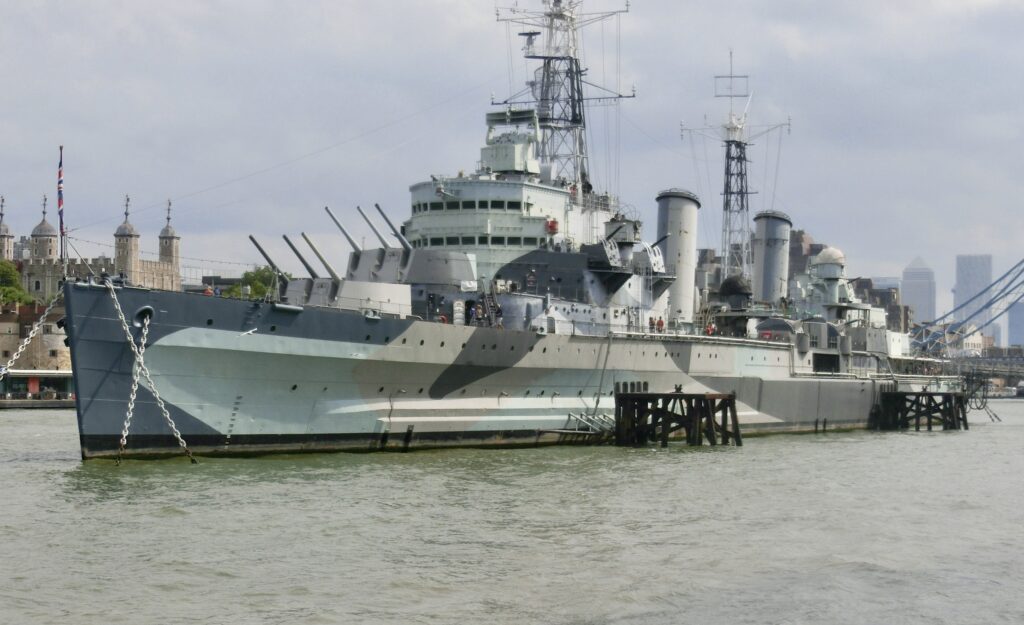
Walking towards Tower Bridge, we passed the cruiser, the HMS Belfast, moored here and famous for the role she played in escorting Artic convoys to the Soviet Union and assisting with the destruction of the German battleship, the Scharnhorst. She is now a museum ship.
The Tower of London.

Golden Hind
Turning back in the direction of London Bridge, we stopped to look at the life size model of the Golden Hind. She was the galleon captained by Sir Francis Drake in his circumnavigation of the world between 1577 and 1580.
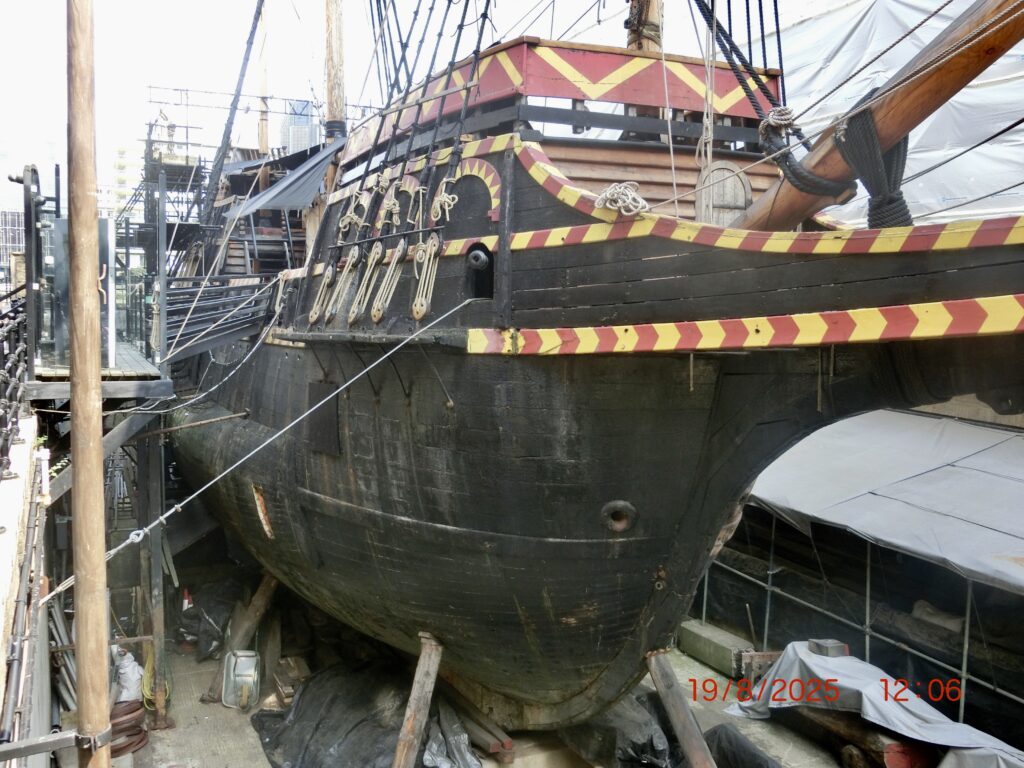
Southwark Cathedral, Borough Market and The George
Passing Southwark Cathedral, we made our way to Borough Market, which we quickly passed through as it was very busy. In Borough High Street we stopped to look at the George pub. It dates back to the 17th century. It is the last surviving galleried inn and coach station, in London and mentioned in Charles Dickens’ Little Dorrit.
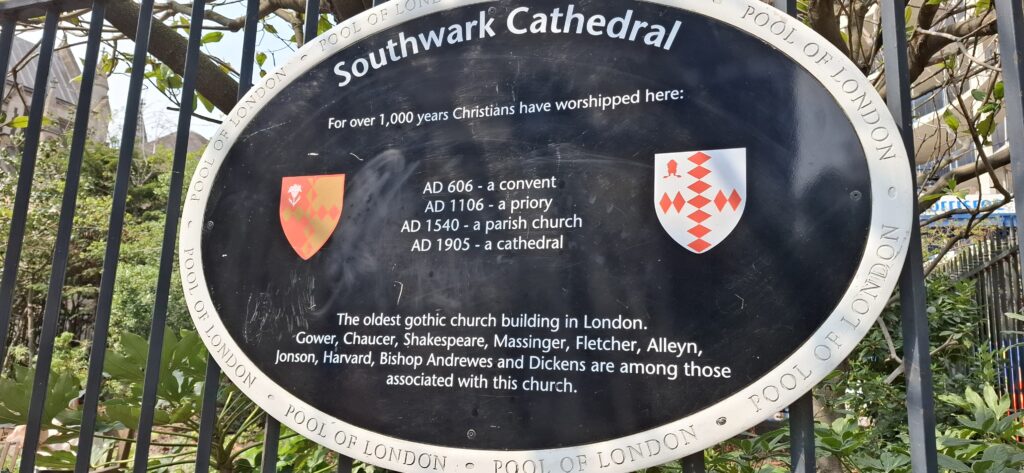
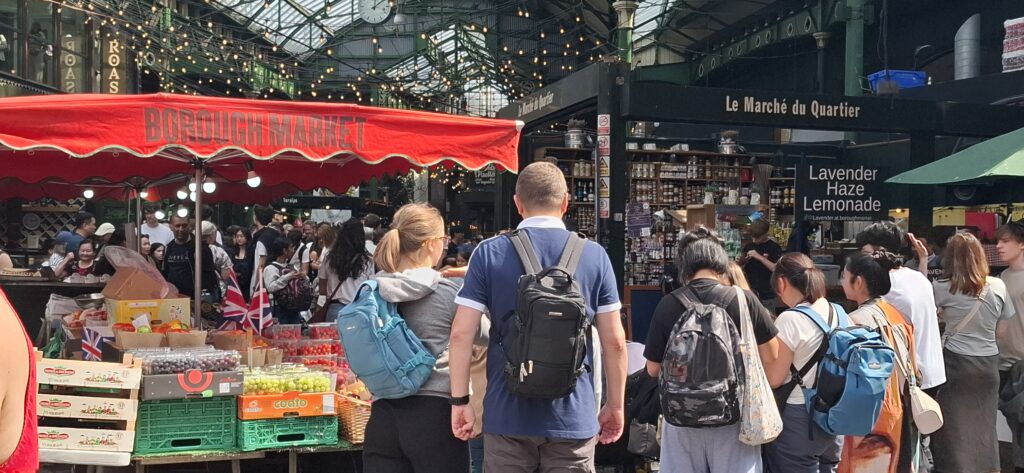
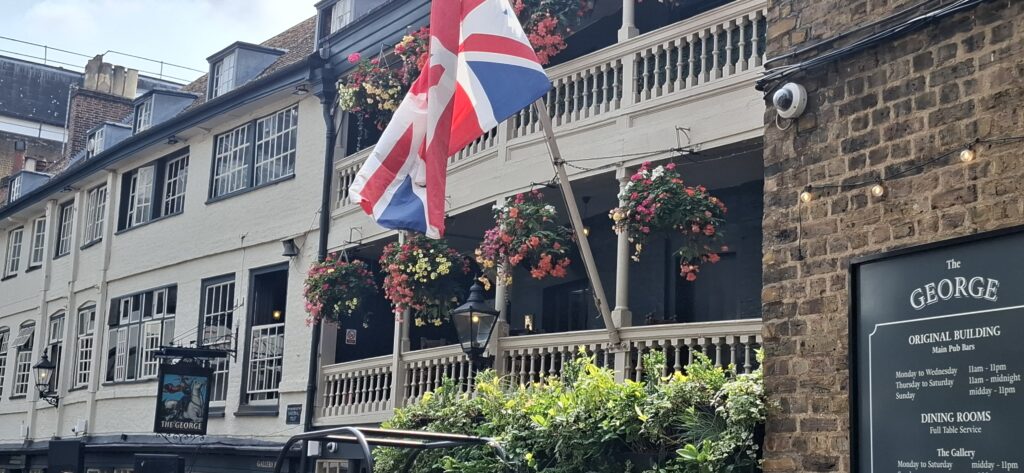
Crossing London Bridge
Now it was time to cross London Bridge to the northern side of the Thames. On crossing the river, our first sight was the Monument. This commemorates the 1666 Great Fire of London. The fire began in a bakery in Pudding Lane, just 202 feet from the site of the Monument today, the height of the monument.
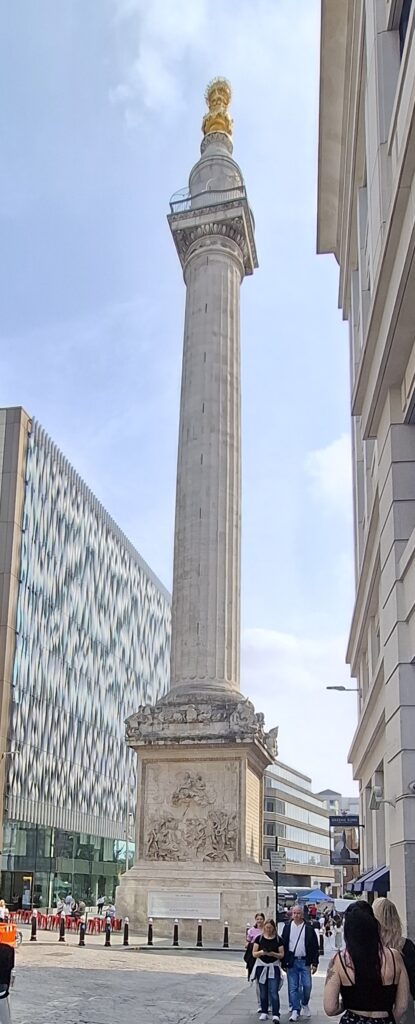
Leadenhall Market and Lloyd’s Building
Venturing further into the City of London, we entered Leadenhall Market. Now boasting boutiques, small shops, cafes and bars, it began life as a Forum in the centre of Roman London. There has been a market on the site since the 14th century. The Victorian arches of today’s market are filled with reminders of a bygone age.
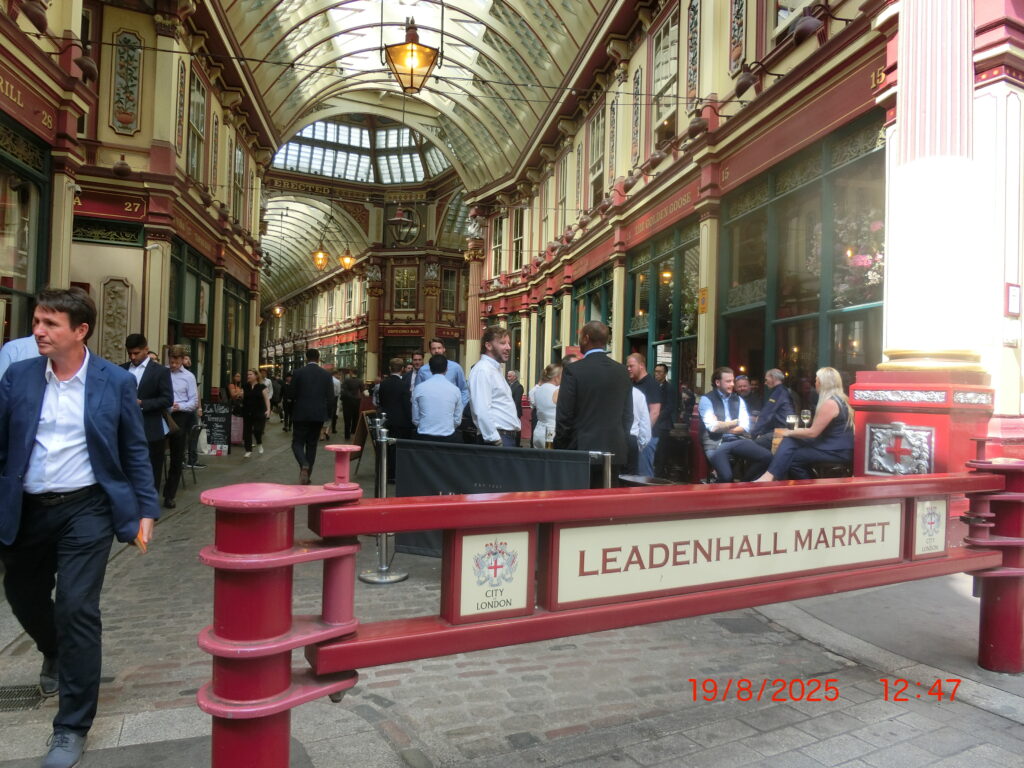
Standing beside all this history is the Lloyd’s of London building, the insurance institution. Sometimes known as the Inside-Out-Building as the ducts and lifts are located on the outside of the building to maximise space.
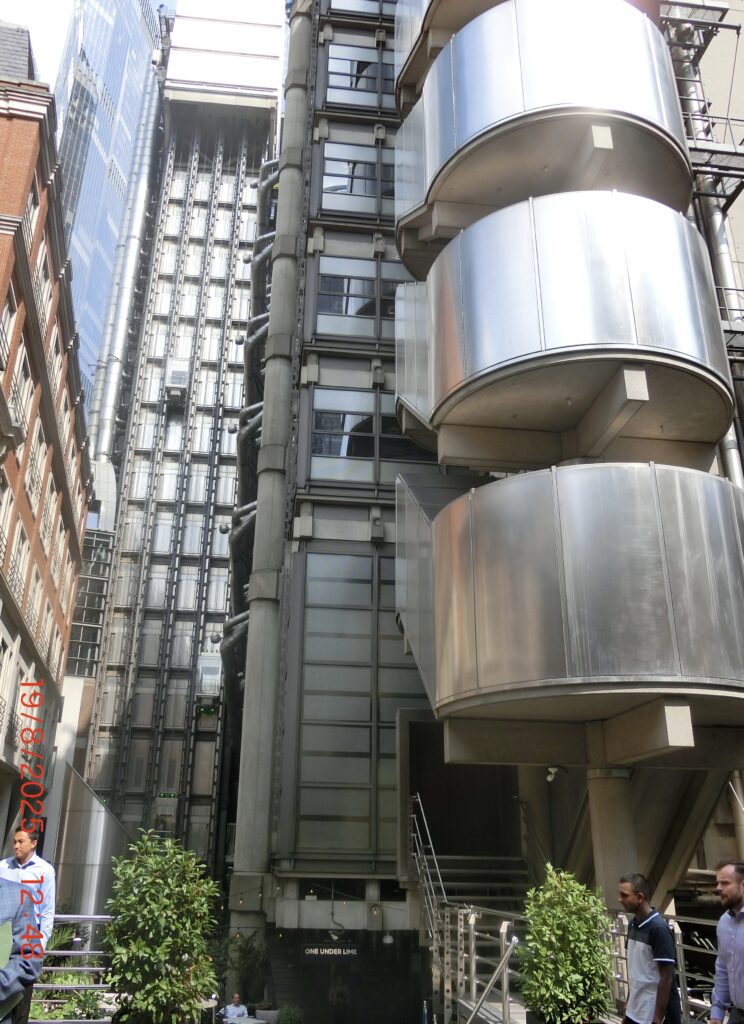
Wandering through small, narrow, original streets, we reached Gracechurch Street and The Crosse Keys pub. An enormous bar in a very grandiose building, the former headquarters of the Shanghai Banking Corporation. Deciding it was time for a break and liquid refreshment, we stopped for a drink.
I realised my son, Tim’s office at the Royal Bank of Canada, couldn’t be far away. We gave him a call and discovered it was 3 minutes walk away in Bishopsgate. As he is hobbling about on crutches and wearing a moon boot, we walked to meet him for an impromptu chat. A lovely surprise.
By this time we were feeling in need of sustenance, so stopped for a sandwich at a Pret A Manger near Saint Paul’s Cathedral, in Paternoster Square. Here there were some interesting posters depicting bomb damage in the area during the Second World War.
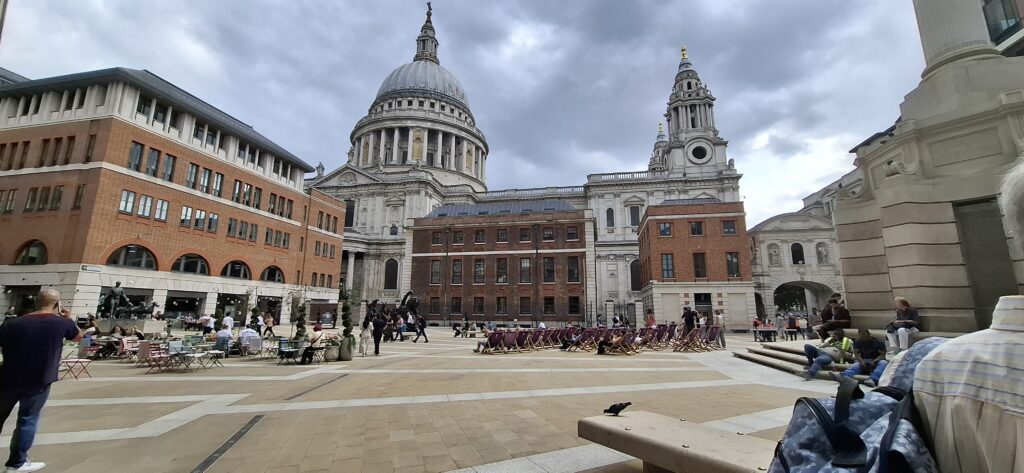
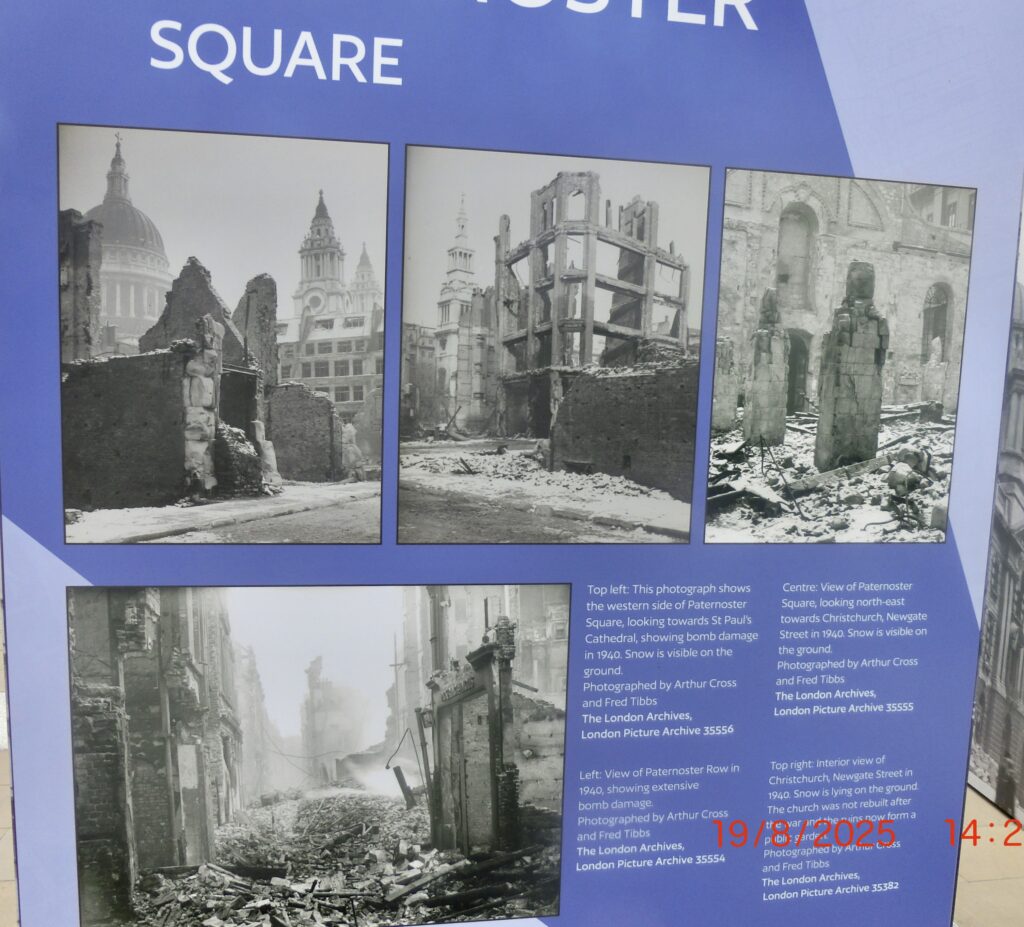
Walking down Threadneedle Street we passed the Bank of England building. Home of the UK’s central bank
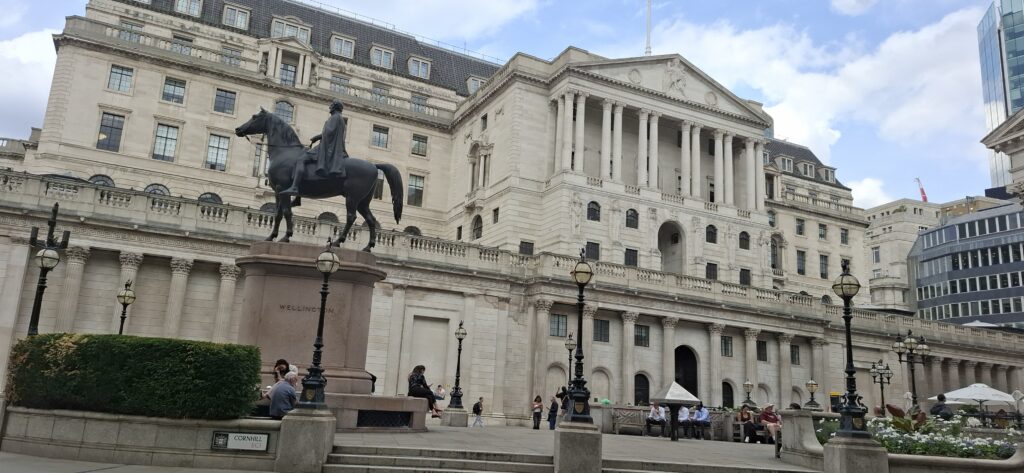
Bank of England with a statue of the Duke of Wellington in the foreground.
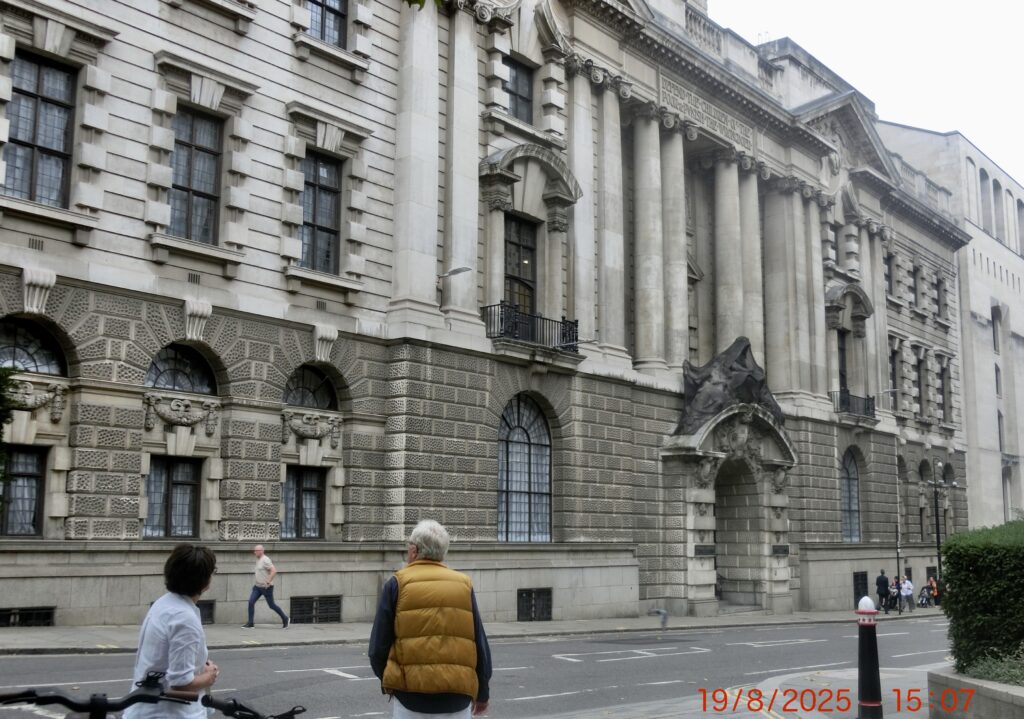
Old Bailey.
Newgate Prison was located at the corner of Newgate Street and Old Bailey, on the site of the former Roman city gate. It was the London Courthouse and a notorious prison for over 700 years, from 1188 until its closure in 1902. Today, the Central Criminal Court known as the Old Bailey, stands on much of the former prison’s site. Edward Gibbon Wakefield, the architect of English settlers in Canada, South Australia and New Zealand, a Whig Politician, spent time in Newgate prison for kidnapping. With his brother’s assistance, they abducted a wealthy schoolgirl Edward wanted to marry. It was while in prison that he developed his plans for sponsoring migration through the New Zealand company. He never visited New Zealand but his son Edward Jerningham held several political positions in New Zealand, where he died in 1879.
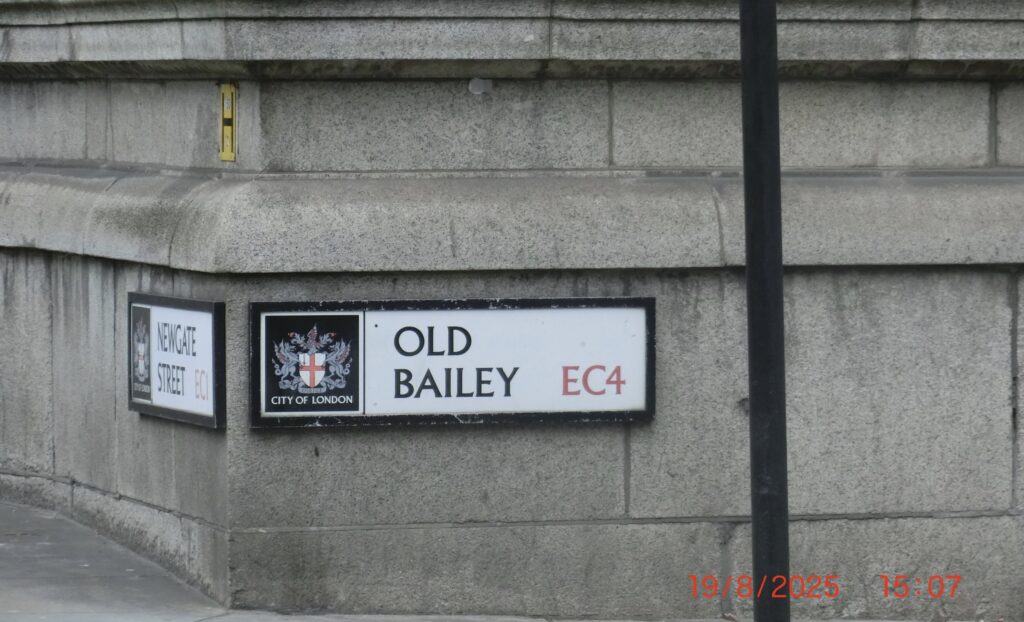
Continuing to High Holborn we stopped at the Cittie of Yorke, another historic pub, for more liquid refreshment. This is a grade 11 listed pub boasting a grand medieval-style hall and historic booths. We settled ourselves in one for a rest and our refreshment.
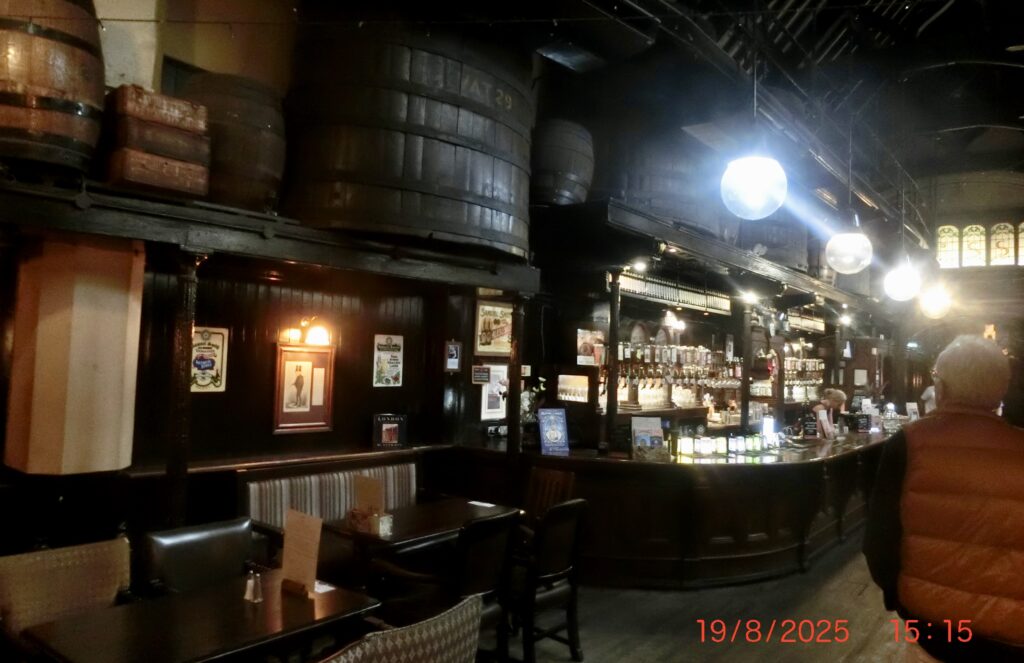
Next we visited the legal area of London, Lincoln’s Inn and Gray’s Inn. These large squares are the home of numerous legal chambers. Neither Dennis nor I had ever visited this part of London before. In the centre of Lincoln’s Inn is Lincoln’s Inn Fields, the largest public square in London. Facing the back of the Royal Courts of Justice is another historic pub, the Seven Stars. We popped in, not for another drink, but for a quick look at the legal paraphernalia decorating the walls and the ridiculously narrow staircase to the toilets. It is purported to be one of the oldest pubs in London, having escaped the Great Fire of London in 1666.
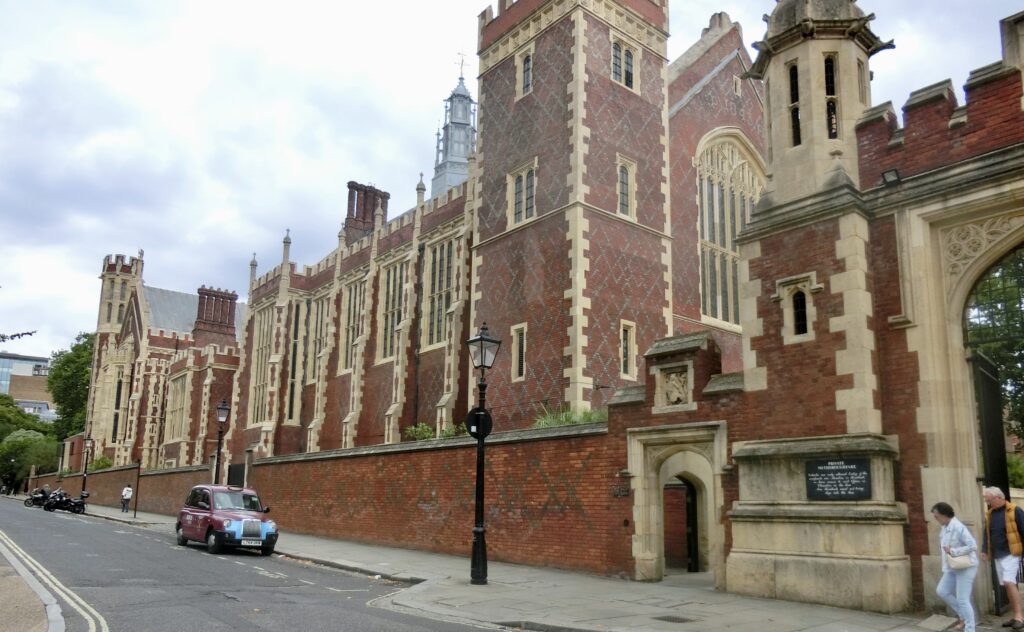
What tour of the area would be complete without the mention of Charles Dickens, who’s house we passed. Unfortunately closed this day.

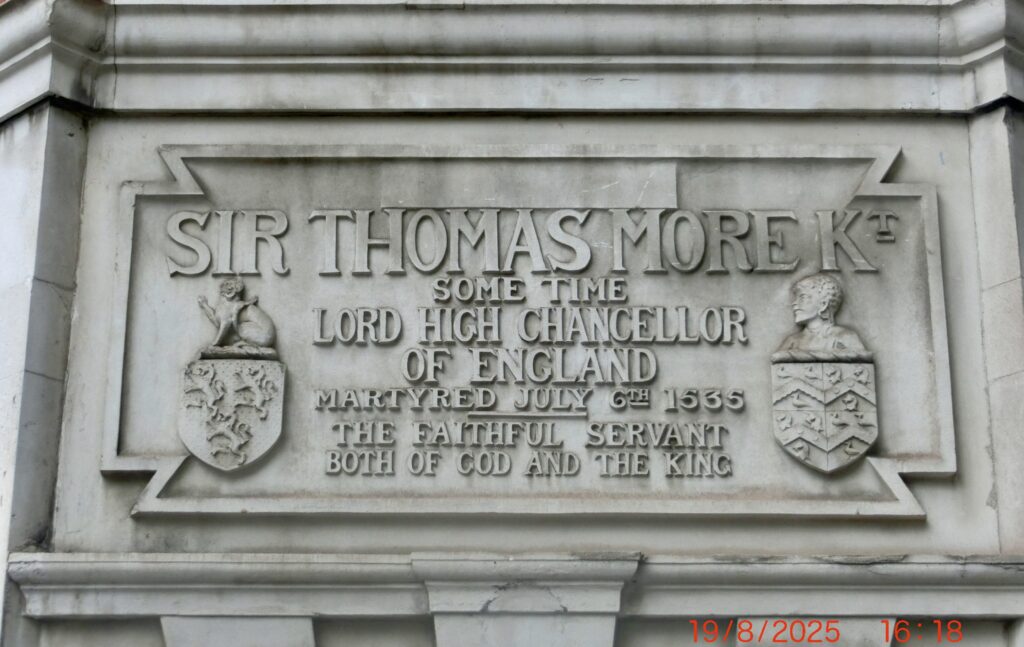
Unfortunately for him, the king didn’t see it that way!
By this time we were feeling rather worn out so made our way towards neighbouring King’s Cross and St Pancras stations. We did stop at an insignificant pub for a rest and another beer before rushing to catch the 18.30 train back to Hassocks. Fortunately, Alex was familiar with the layout at King’s Cross, otherwise I think we would still be searching for the platform. We reached the platform just as a train was pulling in and jumped on. Luckily it was the right one.
It was a really interesting and fascinating tour. It might seem like a bit of a pub crawl, but the pubs were just a significant part of London’s incredible history. (We did visit one more, just for a look. The Art Deco pub in Bloomsbury, The Duke). It is simply the world’s most magnificent city. Thank you, Alex, for an amazing day.
Views: 101

Definitely sounds like a pub crawl to me, will put it on my todo list..
Not intentionally a pub crawl. Really!!😀 London has so much history. Is an amazing city.
Very interesting blog dear friends!! Hello, I don’t know if you’re home yet or still wandering around looking in waste bins for tickets?😄,just to let you know we are having torrential rains at the moment, in between rain I go to inspect your kitchen and amazingly not a drop of water in your tins. Just thought you would like to know? Missing your daily presence in the garden all our love and stay safe Mike and Sylvia xxx
Hello to you Mike, and Sylvia. Yes we are back home and Jen is slaving to return the garden to its former splendour. Me, getting the vehicles ready for inspection certification.
Thank you for checking for drips..but they have migrated south..😎 Encouraging signs though..😊
You are not alone in experiencing rain, we are fortunate to be having some too. I’m sure you will be preparing your lovely garden for the winter. All going to plan, we will look forward to seeing you in the spring. Stay warm and dry.
Him n Her..🥰